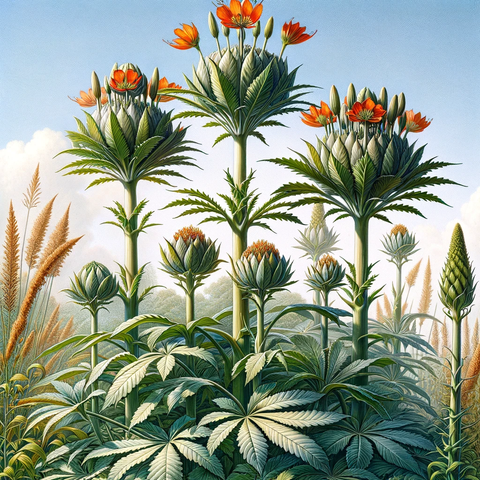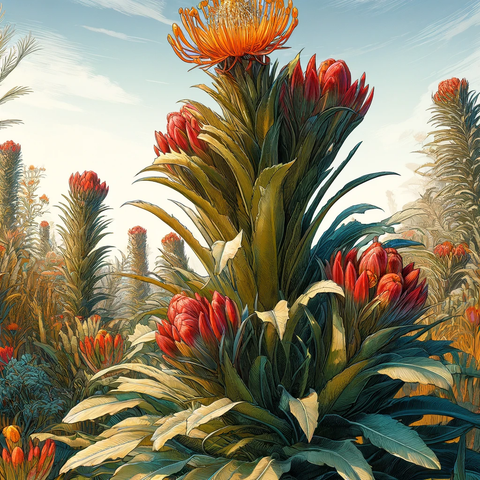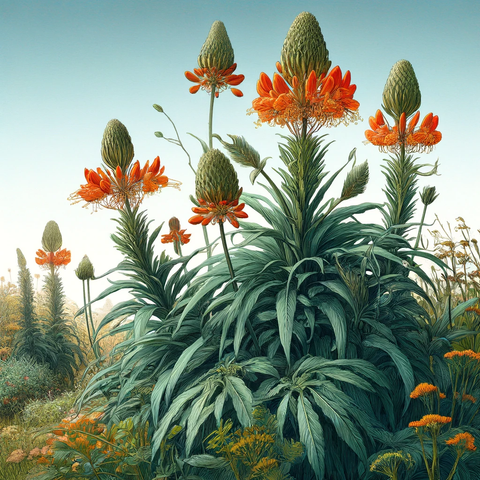
Is Klip Dagga Psychoactive?
Share
Ever heard of a plant nicknamed "lion's tail" that boasts a history steeped in South African tradition and whispers of mind-altering properties? Buckle up, because we're diving deep into the world of Klip Dagga (Leonotis nepetifolia).
This fascinating shrub, native to South Africa's sunny landscapes, has been used for centuries by indigenous cultures. But what truly sparks curiosity is its potential psychoactive side. Does Klip Dagga truly deliver a mind-bending experience, or is it all smoke and mirrors?
This blog post is your one-stop shop for unraveling the mystery. We'll dissect the scientific evidence, explore traditional uses, and delve into the intriguing chemical makeup of Klip Dagga. By the end, you'll have a clearer picture of this South African enigma and whether it lives up to its "wild" reputation.
So, grab a cup of tea (or something stronger, if the rumors are true!), and let's embark on this journey of discovery together!

Cracking the Klip Dagga Code: A Look at its Chemical Cocktail
Klip Dagga's potential for psychoactive effects hinges on its unique chemical composition. Let's delve into the key players in this botanical puzzle:
Unveiling the Stars of the Show
Leonurine: This alkaloid steals the spotlight as the prime suspect for Klip Dagga's psychoactive potential. Some users report mild euphoria, relaxation, and heightened sensory experiences when consuming the plant. However, scientific research on leonurine's specific effects in humans is scarce. It's like having a captivating actor on stage, but the script for its human performance remains unwritten.
Beyond Leonurine: Exploring the Supporting Cast: While leonurine basks in the limelight, other potentially active compounds deserve a mention. Marrubiin, another player in the mix, is known for its anti-inflammatory properties. Labdane diterpenes, a class of organic compounds, might also contribute to the overall effects, but their psychoactive properties in Klip Dagga are yet to be fully explored. Think of them as intriguing background characters with the potential to influence the plot, but more investigation is needed to understand their specific roles.
Sibling Rivalry or Distinct Personalities? Klip Dagga vs. Cannabis
The term "dagga" might lead you to believe Klip Dagga is cannabis' wilder cousin. Not quite! While both plants hail from the mint family, their chemical profiles are distinct. Cannabis' psychoactive punch comes from THC (tetrahydrocannabinol), a well-researched compound known for its mind-altering effects. Klip Dagga, on the other hand, relies on leonurine, a less understood player in the psychoactive game. It's like comparing apples and oranges – they share some family resemblance, but their flavors and effects are vastly different.
Filling the Gaps in Our Knowledge
The truth is, our understanding of Klip Dagga's chemical composition, especially regarding its psychoactive potential, remains incomplete. More comprehensive studies are needed to isolate and analyze these compounds. It's like having a fascinating book with missing chapters. Further research can help us decipher the full story behind Klip Dagga's unique chemistry.
Whispers from the Past: Unveiling Klip Dagga's Traditional Uses in South Africa
For centuries, Klip Dagga has been woven into the fabric of South African cultures. Let's explore how this plant has been traditionally used, keeping a curious eye on potential psychoactive applications:
A Legacy Steeped in Tradition
Klip Dagga's journey in South Africa stretches back generations. Indigenous communities have utilized it for a variety of purposes, some hinting at potential psychoactive effects. Smoke if you dare, but cultural practices suggest uses beyond mere intoxication.
The Relaxation Ritual: Fact or Folklore?
Traditional accounts paint a picture of Klip Dagga being used for relaxation and mood elevation. Some cultures incorporated it into rituals or ceremonies, seeking a calming influence. However, it's crucial to remember that these applications haven't been scientifically confirmed. The psychoactive effects users describe might be due to cultural expectations, the influence of ritual settings, or even the placebo effect. We simply can't be sure without proper scientific investigation.
Beyond the Mind: Exploring Medicinal Applications
It's important to distinguish potential psychoactive effects from Klip Dagga's other traditional uses. South African cultures have also employed the plant for medicinal purposes, such as heart tonics and remedies for anxiety. These applications focus on the plant's potential health benefits rather than altering mental state. While some traditional uses might overlap with the psychoactive realm, it's vital to separate these categories for a clear understanding.
The takeaway? Klip Dagga's history in South Africa is rich and multifaceted. Traditional wisdom offers intriguing glimpses into its potential, but scientific evidence remains elusive. Stay tuned as we delve deeper into the research surrounding this enigmatic plant!

Science Seeks Answers: Unveiling Klip Dagga's Psychoactive Effects Through Research
The million-dollar question: Does Klip Dagga truly deliver a psychoactive experience, or is it all hearsay? Buckle up, because science is on the case, albeit with some intriguing roadblocks to navigate.
The Glaring Gap in Knowledge
Let's be honest – scientific research on Klip Dagga's psychoactive effects in humans is scarce. We have more questions than definitive answers. This lack of data makes it challenging to say for certain what, if any, mind-altering properties the plant possesses.
Borrowing from the Animal Kingdom: A Peek at Mice Studies
While human studies are lacking, some researchers have turned to animal models to shed light on Klip Dagga's potential effects. Studies involving mice, for example, have explored the possibility of sedative properties. Klip Dagga extracts reportedly extended the sleep duration of mice already sedated with diazepam. However, it's crucial to remember a critical caveat: results from mice don't automatically translate to humans. Our physiology and responses to plant compounds can differ significantly. So, while these animal studies offer a starting point, they can't definitively prove psychoactive effects in people.
Untangling the Chemical Web: Isolating the Psychoactive Culprit
Another hurdle in Klip Dagga research lies in its complex chemical makeup. Isolating and studying specific compounds, like the suspected psychoactive player leonurine, presents a challenge. It's like trying to identify a single instrument in a full orchestra – the plant's many components can make pinpointing the exact contributor to psychoactive effects a tricky task.
The Call for Clinical Trials: Separating Fact from Fiction
To truly understand Klip Dagga's psychoactive potential in humans, well-designed clinical trials are essential. These studies would involve administering the plant to human participants under controlled settings and monitoring any psychological or physiological changes. This approach allows researchers to gather reliable data on Klip Dagga's effects, separating fact from folklore.
The scientific journey to understand Klip Dagga's psychoactive properties has just begun. While animal studies offer hints and the plant's chemistry holds potential clues, definitive answers await well-designed clinical trials in humans. Stay tuned, because as research progresses, the true story behind Klip Dagga's psychoactive effects may finally come into focus.

Navigating the Legal Landscape and Safety Considerations of Klip Dagga
While we delve into the science behind Klip Dagga, it's crucial to address the legalities and potential safety concerns surrounding its use.
Legal Landscape: A Patchwork of Regulations
The legal status of Klip Dagga varies depending on your location. In some regions, it might be freely available, while others might have restrictions or even bans in place. It's vital to do your research and understand the legal implications of possessing or using Klip Dagga where you live. Remember, legal allowances can change, so staying updated on local regulations is key.
Safety First: The Unknown Factors
Since scientific research on Klip Dagga's safety profile is limited, there's a lack of comprehensive data on potential risks. The possibility of interactions with medications or unknown side effects remains a concern. For instance, Klip Dagga might have properties that could influence blood pressure or heart rate, potentially causing complications for those with pre-existing conditions.
Responsible Use: Knowledge is Power
Before considering using Klip Dagga, consulting a healthcare professional is paramount. They can assess your individual health and advise you on potential risks based on your medical history and any medications you're taking. Remember, responsible use starts with knowledge. Consulting a healthcare professional empowers you to make informed decisions about Klip Dagga and prioritize your well-being.

Unveiling the Mystery: Alternative Explanations for Klip Dagga's Traditional Uses
The traditional applications of Klip Dagga for relaxation, mood elevation, and calming effects raise the question: are these experiences truly psychoactive, or could there be alternative explanations?
The Power of Belief: Exploring the Placebo Effect
The placebo effect, a fascinating phenomenon in human psychology, can't be discounted. If users believe Klip Dagga will induce relaxation, their expectations might influence their perception. This doesn't diminish the reported effects, but it suggests the plant might not directly alter brain chemistry.
A Botanical Orchestra: More Than Just Leonurine
Klip Dagga is a complex blend of various compounds. While leonurine takes center stage as the suspected psychoactive component, other plant parts might contribute. These could possess calming or mood-altering properties, either independently or synergistically with leonurine. More research is needed to explore this botanical orchestra and its potential impact.
Setting the Stage: Cultural Context and Rituals
Cultural context and ritualistic practices surrounding Klip Dagga use can't be ignored. The environment, social setting, and expectations associated with rituals could influence perceived effects. For instance, a calming tea ceremony might induce relaxation regardless of the plant's inherent properties.
By considering these alternative explanations, we gain a more nuanced understanding of Klip Dagga's traditional uses. While psychoactive effects remain a possibility, the interplay of belief, plant chemistry, and cultural context deserves exploration alongside scientific research.
Conclusion
Our exploration of Klip Dagga has painted a captivating picture – a plant steeped in tradition with whispers of potential psychoactive effects. We've delved into its intriguing chemical composition, explored its historical uses in South Africa, and examined the limited scientific research available.
While the presence of leonurine and traditional accounts hint at psychoactive potential, conclusive evidence in humans remains elusive. Animal studies offer glimpses, but can't definitively translate to human experiences. Further research, particularly well-designed clinical trials, is crucial to understand Klip Dagga's true effects.
Remember, the legal status of Klip Dagga varies by region, and comprehensive safety data is lacking. Responsible use, prioritizing your health, and consulting a healthcare professional are essential before considering it.
Klip Dagga's story is far from over. As scientific research progresses and the veil lifts on its mysteries, a clearer picture of this fascinating "lion's tail" will emerge. Stay tuned for future updates as this botanical enigma continues to unfold!

